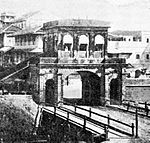Kamalnayan Bajaj Hall and Art Gallery
Art museum and gallery stubsArt museums and galleries established in 1980Art museums and galleries in MumbaiEvent venues established in 1980Use Indian English from October 2024

Kamalnayan Bajaj Hall and Art Gallery is an art gallery in Mumbai, India.
Excerpt from the Wikipedia article Kamalnayan Bajaj Hall and Art Gallery (License: CC BY-SA 3.0, Authors, Images).Kamalnayan Bajaj Hall and Art Gallery
Barrister Rajni Patel Marg, Mumbai Zone 1 (Mumbai)
Geographical coordinates (GPS) Address Phone number Website Nearby Places Show on map
Geographical coordinates (GPS)
| Latitude | Longitude |
|---|---|
| N 18.925983333333 ° | E 72.822463888889 ° |
Address
Blue Tokai Coffee | Nariman Point
Barrister Rajni Patel Marg 18 CR2 Mall
400021 Mumbai, Zone 1 (Mumbai)
Maharashtra, India
Open on Google Maps








